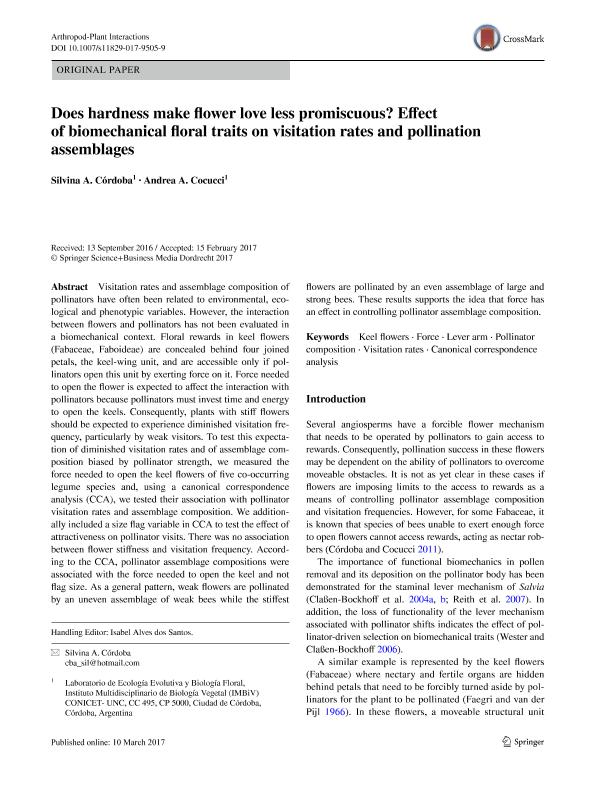Mostrar el registro sencillo del ítem
dc.contributor.author
Córdoba, Silvina Alejandra

dc.contributor.author
Cocucci, Andrea Aristides

dc.date.available
2023-11-06T12:17:32Z
dc.date.issued
2017-09
dc.identifier.citation
Córdoba, Silvina Alejandra; Cocucci, Andrea Aristides; Does hardness make flower love less promiscuous? Effect of biomechanical floral traits on visitation rates and pollination assemblages; Springer; Arthropod-plant Interactions; 11; 3; 9-2017; 299-305
dc.identifier.issn
1872-8855
dc.identifier.uri
http://hdl.handle.net/11336/217062
dc.description.abstract
Visitation rates and assemblage composition of pollinators have often been related to environmental, ecological and phenotypic variables. However, the interaction between flowers and pollinators has not been evaluated in a biomechanical context. Floral rewards in keel flowers (Fabaceae, Faboideae) are concealed behind four joined petals, the keel-wing unit, and are accessible only if pollinators open this unit by exerting force on it. Force needed to open the flower is expected to affect the interaction with pollinators because pollinators must invest time and energy to open the keels. Consequently, plants with stiff flowers should be expected to experience diminished visitation frequency, particularly by weak visitors. To test this expectation of diminished visitation rates and of assemblage composition biased by pollinator strength, we measured the force needed to open the keel flowers of five co-occurring legume species and, using a canonical correspondence analysis (CCA), we tested their association with pollinator visitation rates and assemblage composition. We additionally included a size flag variable in CCA to test the effect of attractiveness on pollinator visits. There was no association between flower stiffness and visitation frequency. According to the CCA, pollinator assemblage compositions were associated with the force needed to open the keel and not flag size. As a general pattern, weak flowers are pollinated by an uneven assemblage of weak bees while the stiffest flowers are pollinated by an even assemblage of large and strong bees. These results supports the idea that force has an effect in controlling pollinator assemblage composition.
dc.format
application/pdf
dc.language.iso
eng
dc.publisher
Springer

dc.rights
info:eu-repo/semantics/openAccess
dc.rights.uri
https://creativecommons.org/licenses/by-nc-sa/2.5/ar/
dc.subject
CANONICAL CORRESPONDENCE ANALYSIS
dc.subject
FORCE
dc.subject
KEEL FLOWERS
dc.subject
LEVER ARM
dc.subject
POLLINATOR COMPOSITION
dc.subject
VISITATION RATES
dc.subject.classification
Biología

dc.subject.classification
Ciencias Biológicas

dc.subject.classification
CIENCIAS NATURALES Y EXACTAS

dc.title
Does hardness make flower love less promiscuous? Effect of biomechanical floral traits on visitation rates and pollination assemblages
dc.type
info:eu-repo/semantics/article
dc.type
info:ar-repo/semantics/artículo
dc.type
info:eu-repo/semantics/publishedVersion
dc.date.updated
2023-11-06T09:52:41Z
dc.journal.volume
11
dc.journal.number
3
dc.journal.pagination
299-305
dc.journal.pais
Alemania

dc.journal.ciudad
Berlin
dc.description.fil
Fil: Córdoba, Silvina Alejandra. Consejo Nacional de Investigaciones Científicas y Técnicas. Centro Científico Tecnológico Conicet - Córdoba. Instituto Multidisciplinario de Biología Vegetal. Universidad Nacional de Córdoba. Facultad de Ciencias Exactas Físicas y Naturales. Instituto Multidisciplinario de Biología Vegetal; Argentina
dc.description.fil
Fil: Cocucci, Andrea Aristides. Consejo Nacional de Investigaciones Científicas y Técnicas. Centro Científico Tecnológico Conicet - Córdoba. Instituto Multidisciplinario de Biología Vegetal. Universidad Nacional de Córdoba. Facultad de Ciencias Exactas Físicas y Naturales. Instituto Multidisciplinario de Biología Vegetal; Argentina
dc.journal.title
Arthropod-plant Interactions

dc.relation.alternativeid
info:eu-repo/semantics/altIdentifier/url/https://link.springer.com/article/10.1007/s11829-017-9505-9
dc.relation.alternativeid
info:eu-repo/semantics/altIdentifier/doi/http://dx.doi.org/10.1007/s11829-017-9505-9
Archivos asociados
